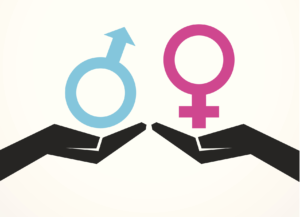
Person reading bills on sofa
The brownstone I lived in for eight months in 2009 and 2010 had few amenities – the building often smelled like leaking pipes, the carpets were threadbare in many places, and the steam heater in the corner was completely out of my control, resulting in quite a few freezing mornings and sweltering nights. It did, however, have a gas stove and oven which, the landlord had told me, was pretty new and “worked great.”
Unfortunately, everything else in the unit was electric, which meant that I’d need to set up separate utility accounts and pay for the gas every month just to run the stove and range.
“It’s like $10 to turn it on and then another $20-$30 per month depending on how much you use it,” she explained.
Yeah, I’m just not going to do that, then, I thought, doing the math in my head.
At that point, $30 was just a little bit less than my take-home after a day of making lattes, which is what I was doing every day that I wasn’t at my public radio internship. The rent on the apartment – which was the least expensive I could find in Seattle – was already going to cost well more than half of my monthly income. With student loan payments to top it off, I barely had living expenses to speak of, and the extra money I’d spend on the gas just didn’t seem worth it.
This wasn’t my first go-round with poverty: We grew up without much money, and I supported myself through college. But after graduation – when the student loan envelopes started showing up and I had to move out of my inexpensive college town to a city that actually had jobs – the situation was dire. But I knew how to handle it.
Every month, I’d scrutinize my budget, looking for things to trim or ways to increase my earnings.
I moonlit as a cocktail waitress. I considered selling plasma (again), but the bus ride to the clinic was too long to fit into my days. I didn’t have a car or health care (or a stove). I picked up odd jobs on Craigslist, receiving cash under the table for nights of cocktailing or working as a cater waiter. I visited food banks. I never bought clothing. I stopped shaving to save money on razors.
Eventually, I was able to get a slightly more lucrative job, began piling on freelance work, and basically never looked back.
I am very, very confident that I did everything in my power to provide myself the best life possible as a young adult, and that the choices I made were the correct choices. My life now would indicate that that’s the case. And still, without fail, when I tell someone or write about that time in my life, I’m met with a cascade of advice.
Well-meaning people who have never been poor are convinced that they know what I should have done. That subtle tweaks to my budget could somehow stretch my $9.50 per hour. I should have gotten a roommate. I should have lived somewhere cheaper. I should have found a better job.
Anyone who’s ever lived in poverty has probably had this experience.
In the US, we have become so accepting of the fact that poverty is not a symptom of a grossly unequal economy, or the result of numerous systemic failures, or the product of years of trickle-down economics, but instead, that the only thing standing between a poor person and the life of their dreams is their own decisions, their own choices, and their own failures.
This is why I would advise any person whose immediate reaction upon hearing about a friend, relative, or stranger on the Internet who is living in poverty is to offer unsolicited advice to hold their tongue (or fingers), at least long enough to consider what other forces contribute to poverty and how their “help” may actually be insulting, incorrect, and downright damaging.
The Most Common Advice Doesn’t Add Up
The over-simplification of poverty is often apparent in the advice that gets disseminated by people who have money and companies who make money off of other people’s financial predicaments.
Earlier this year, an infographic circled around which underscored this fact. Created by a company called InvestmentZen, the infographic showed how to “build wealth on the minimum wage.”
Aside from the fact that it contained numerous logistical issues – it used the federal minimum wage, which isn’t accurate in most states, either because their wage is higher or lower due to tip-crediting – the graphic also seemed to be concerned about moralizing the decisions of poor people and less about actually helping anyone.
Advice from the graphic included “learning skills on YouTube,” only eating in-season produce, and remembering that “the best things in life are free.”
“You can make excuses, or you can do something about it,” the graphic chided. “It’s your choice to make.”
Twitter instantly took it to task; the response was so heated that it eventually led one of the men responsible for circulating to issue a retraction, calling many of the criticisms “fair.”
I suspect that the graphic was so easily mocked because the advice it selected was familiar. Despite the myriad systemic reasons that many people live in poverty, there are a handful of “tips” that well-meaning (most of the time) folks recycle with alarming regularity.
Move somewhere cheaper. Buy in bulk. Get rid of your car. Get a roommate. Eat out less.
These changes seem simple – if you just spent less money on groceries, you’d have more money! If you didn’t have a car, you could save hundreds on car insurance! – but they fail to take into account one crucial element of humanity and existence: The dollar amount of a thing doesn’t fully capture the value of it.
Most people who live in poverty are working jobs where their income is determined by how many hours they can spend on the job, which often don’t fall within typical commuting hours, and often run well over forty hours per week.
When you’re poor, your time – especially your free time – is extremely precious. And many of the prescribed tips for saving money cut into that free time, make it less enjoyable, or might even actively cost more money in the short term.
I’ve written before about the actual cost of moving – renting a truck, putting down a deposit, the financial hit of taking time off work to move – but recommending that someone relocate their entire life to save on rent also neglects to account for the real value of living in a place with a support system.
Whether it’s a family by birth or by choice, living near people you know offers a sense of responsibility and place – not to mention a couch to crash on if you get evicted and the potential for free childcare or other assistance.
To illustrate this point, let’s use another common tip: giving up a car.
Access to transit is one of the single biggest investments that communities can make to help people get out of poverty. But overwhelmingly, transit systems are failing poor people. And for seniors or disabled people, taking the bus may be even more difficult if cities and transit authorities don’t accommodate for various mobility, vision, or hearing impairments.
Which means that the cost (both figurative and literal) of giving up a car might be steeper than keeping it. Which means that even if a person makes the choice to save money by riding the bus, the bus may not be there for them.
There’s also the issue of time and convenience, particularly if you live in a smaller city, which tend to have much spottier bus service.
We can look at it like this: Estimated cost of owning a car over a year: about $725 per month, according to AAA. That’s a lot, but compared to riding the bus (because let’s assume a person doesn’t have the upfront cash for a bike, a lock, and the gear they might need to commute in all weather), it’s not really.
Where I live, it costs about $5 per day to commute via bus, assuming I’m traveling inside the city and just going to work and back using a single method of transit. Multiply that by five days per week (though most people working minimum wage work more than that), and it’s about $100 per month. That’s still less than $725 – until you account for:
Two hours of commuting compared to thirty minutes of commuting (at $13/hour): $19.50/day in lost income, or $390 per month.
Cost of an extra hour of childcare to account for the commute time (at $13/hour, as well): $260 per month
The cost of using the bus for weekly grocery trips (which limit the choices a person has and reduces the ability to buy in bulk, another favorite piece of advice for people with means to give to poor people) and the occasional other appointment: about $50 per month.
Which equals $800 – and doesn’t take into account the fact that grocery shopping by bus is not ideal for someone with kids in tow. Additionally, taking the bus to get groceries makes it less likely that a person can comparison shop, visit multiple stores for ultimate savings, and purchase products that are less easy to carry, like fresh produce or bulk items.
You can also see from this example how interconnected so many of these pieces of advice are.
“Get rid of your car” is a fine piece of advice in a vacuum, but when it’s coupled with “drive for Uber to make extra money,” you’ve now prescribed something that’s literally impossible. “Spend less on groceries” is fine on its own, but if you’re also recommending that someone switch to commuting by bike or bus and move to a less dense place with fewer food choices, you’ve now quadrupled the daily difficulty of their life.
And that has a real cost, even if it’s not tangible or numeric.
This, I think, is truly at the heart of the advice we tend to offer poor people: It implicitly says that we believe that they should be willing and able to exchange their own time on earth, comfort, happiness, and even physical health and safety just to scrape by.
Being Poor Is Really Expensive
The assumption that “simple advice” can dramatically change a person’s economic outlook assumes that a person’s poverty is solely the result of personal failings, rather than very real and costly systems of oppression, including legacy poverty, systemic racism, mass incarceration, punitive immigration policies, medical debt, and more.
Regardless of the personal choices a family might make to save money, there are some unavoidable costs that are baked into our financial and social systems.
Overdraft fees, late fees on missed bills, high-interest credit card fees, and payday lenders are just a few ways that poverty begets higher expenses. The average payday loan borrower – who is usually short just a few hundred dollars between paychecks – ends up paying more than 300% interest on their initial amount.
These companies make billions each year by offering people a necessary service that costs them an outrageously inflated price.
Banks also find ways to capitalize on people without money. Many checking accounts require that a person carry a minimum balance – and fine customers for every month that they don’t meet the requirement. And that’s assuming a person even uses a bank! An estimated 8% of Americans don’t use a bank, largely due to their low monthly income. As a result, they pay more money in fees at check cashing businesses or by using prepaid debit cards.
In addition to these fees and fines, a lack of funds in-hand can also mean paying more for services and products. Whether it’s putting charges on a credit card and paying interest or buying in smaller denominations (and thus paying more per unit), there are hundreds of small ways that being cash-poor can make it harder to save.
The Washington Post reported on a study on this subject:
When [researchers] compared households with similar consumption rates shopping at comparable stores – and controlling for two-ply TP – they found that the poor were less likely than wealthier households to buy bigger packages, or to time their purchases to take advantage of sales. By failing to do so, they paid about 5.9% more per sheet of toilet paper – a little less than what they saved by buying cheaper brands in the first place (8.8%).
Poor folks don’t buy single-use items because they never thought about buying in bulk – it’s often because they literally don’t have the money to do so, or don’t have a way to get bulk items home.
Our broken immigration system is also responsible for trapping new Americans (and their children) in low-income jobs, substandard housing, and legitimately dangerous transportation and work situations – all of which have a compounding effect on poverty.
Each year, immigrants pay billions into our tax coffers, only to get the short end of the economic stick.
New Americans are less likely to report wage theft, may experience housing discrimination, and of course, often have to pay massive sums of money to travel, bring relatives to the county, and send money back to their nation of origin.
And if you want to begin the process of obtaining citizenship? Expect to cough it up. Just becoming a US citizen can cost up to $900.
Mass incarceration also has a stark economic impact, specifically on the Black community – a population that already sees lower lifetime earnings and increased rates and instances of poverty.
One in four Black children born in the era of mass incarceration will have a parent who is incarcerated, which will limit that parent’s earning by an average of 40% over their lifetime. The cycle of incarceration is expensive at every single step – from the cost of arrests, legal fees, and fines, parole, and lost jobs and hours on the clock, evictions, and so much more – and effectively traps people in a feedback loop of poverty that’s nearly impossible to break.
Even those who aren’t themselves incarcerated pay for incarceration, though. The cost of visiting a spouse in prison (both in lost time and expenses), inflated commissary bills, prohibitively expensive phone bills, the cost of lost time due to traveling, court dates, and meetings, and legal fees make it impossible for some families to dig out.
Having poor parents also puts in motion a cycle of disadvantage (and not because poor people are just worse at raising their children). The vast majority of people who grow up poor stay poor for a variety of complex reasons – which means no amount of coupon-cutting or Costco shopping can dig some families out of poverty, and to suggest otherwise is just disrespectful.
Personal Choices Don’t Fix a Broken System
The InvestmentZen infographic was roundly mocked because it was a symptom of a larger problem, which is that people with means love to give advice to poor people. This serves two distinct purposes:
- It makes people with means feel better about their means because they feel like they have wealth as a direct result of their own effort – and not systems and structures that helped them along the way; and
- It makes people with means feel better about those systems, rather than being forced to confront them or work to dismantle them.
When the infographic said that a person “can’t earn minimum wage and live in an expensive city and be wealthy,” they weren’t telling a lie – but they were accepting implicitly that it’s okay for people who work full-time to live in poverty if they live in large cities.
Imagine if everyone took that advice – if every person working minimum wage up and fled all of the major cities to go live and work in smaller markets with less expensive rent. Cities literally could not function.
Despite the commonly held belief that only teens should or do work for the minimum wage, the fact of the matter is that millions of Americans of all ages, a/genders, and educational levels support their families on hourly low-wage jobs. That includes seniors, disabled people, and women of color.
The answer, then, is not that poor people live differently, but instead, that we create a society and an economy where people who work full time can live in the community where they work.
No amount of cutting back on luxury spending or driving extra hours for Uber can change the fact that there is literally nowhere in the country where a minimum wage job can support a family, that good union jobs have been in decline for decades, or that housing costs have priced people out of their homes. Cutting coupons, commuting by bike, and enjoying outdoor activities can’t really fix that.
So, instead of telling poor people what they should do to work around a system that’s leaving more and more people behind every year, we need to consider how the system can bend and change to better fit the needs of all people.
[do_widget id=’text-101′]
Hanna Brooks Olsen is a Contributing Writer for Everyday Feminism, a small human, and a Millennial. Her interests are politics, podcasts, Pac-12 football, feminism, and Oxford commas. She is curious to a fault. Follow her on Twitter and Medium @mshannabrooks. Read her articles here.
Search our 3000+ articles!
Read our articles about:
Our online racial justice training
Used by hundreds of universities, non-profits, and businesses.
Click to learn more
Most Read Articles
- « Previous
- 1
- …
- 30
- 31
- 32



















